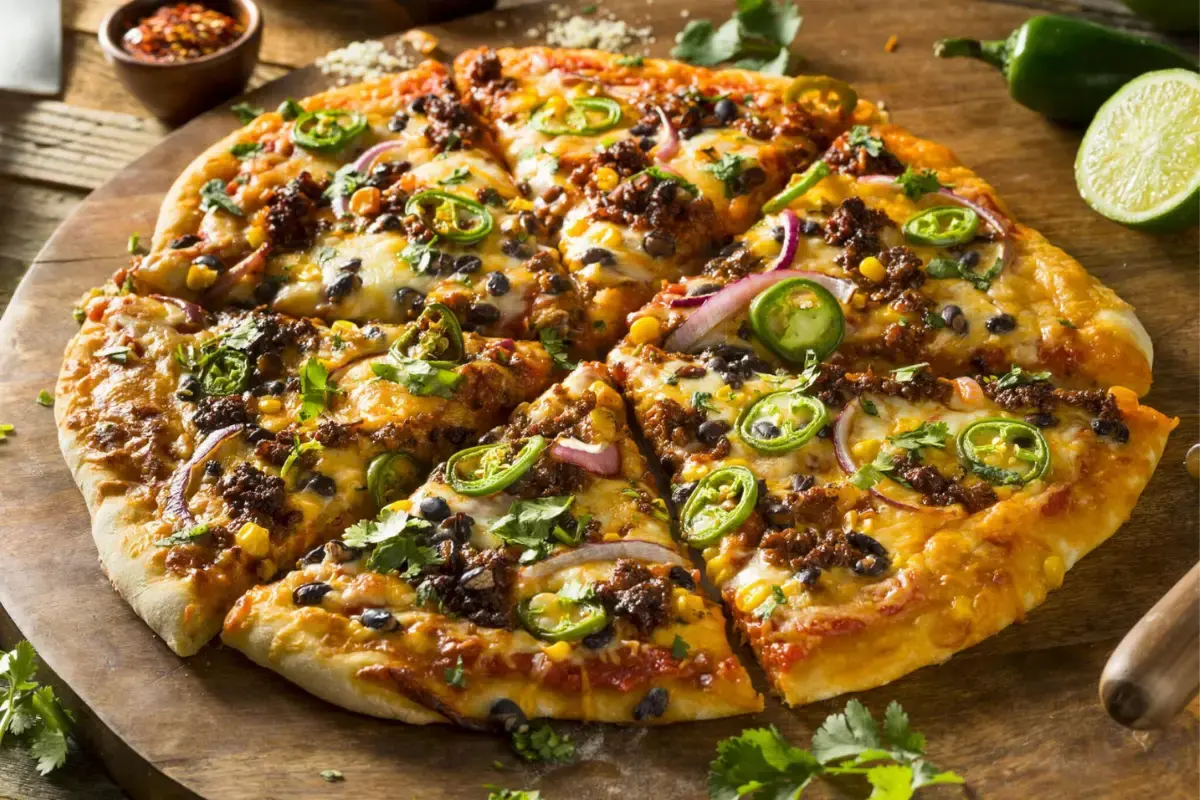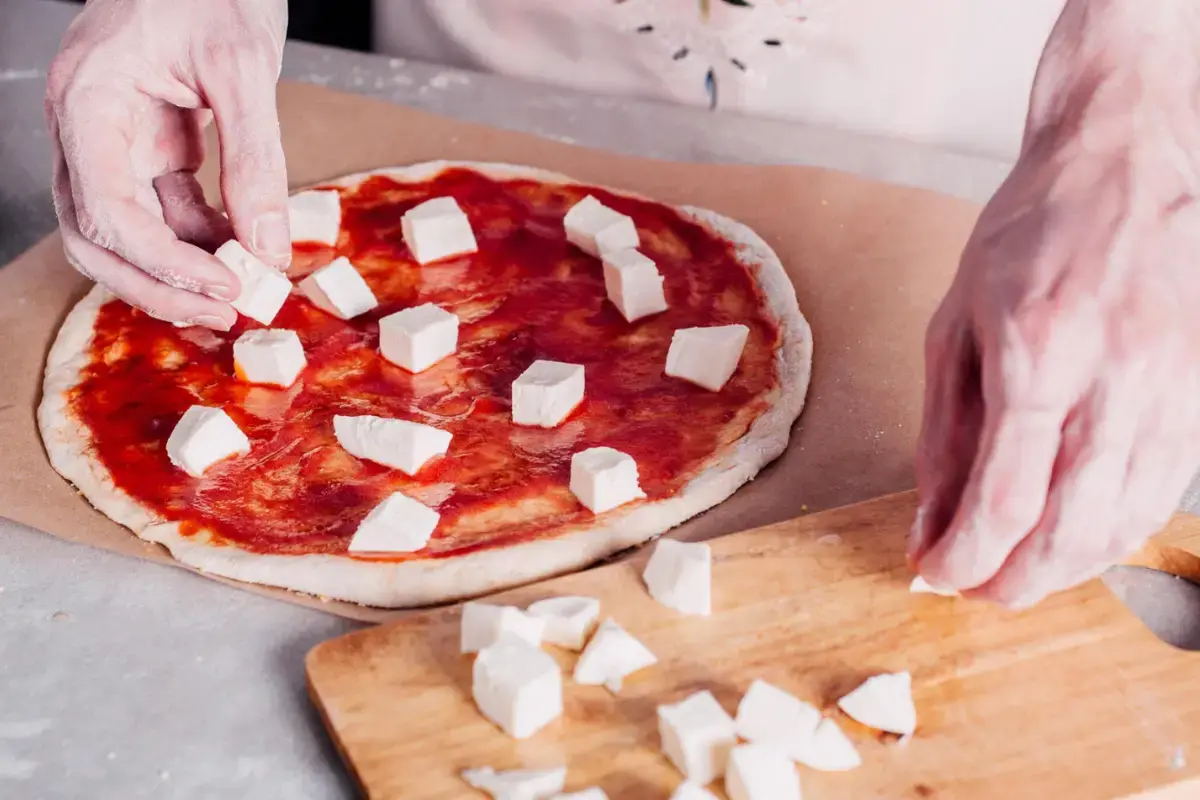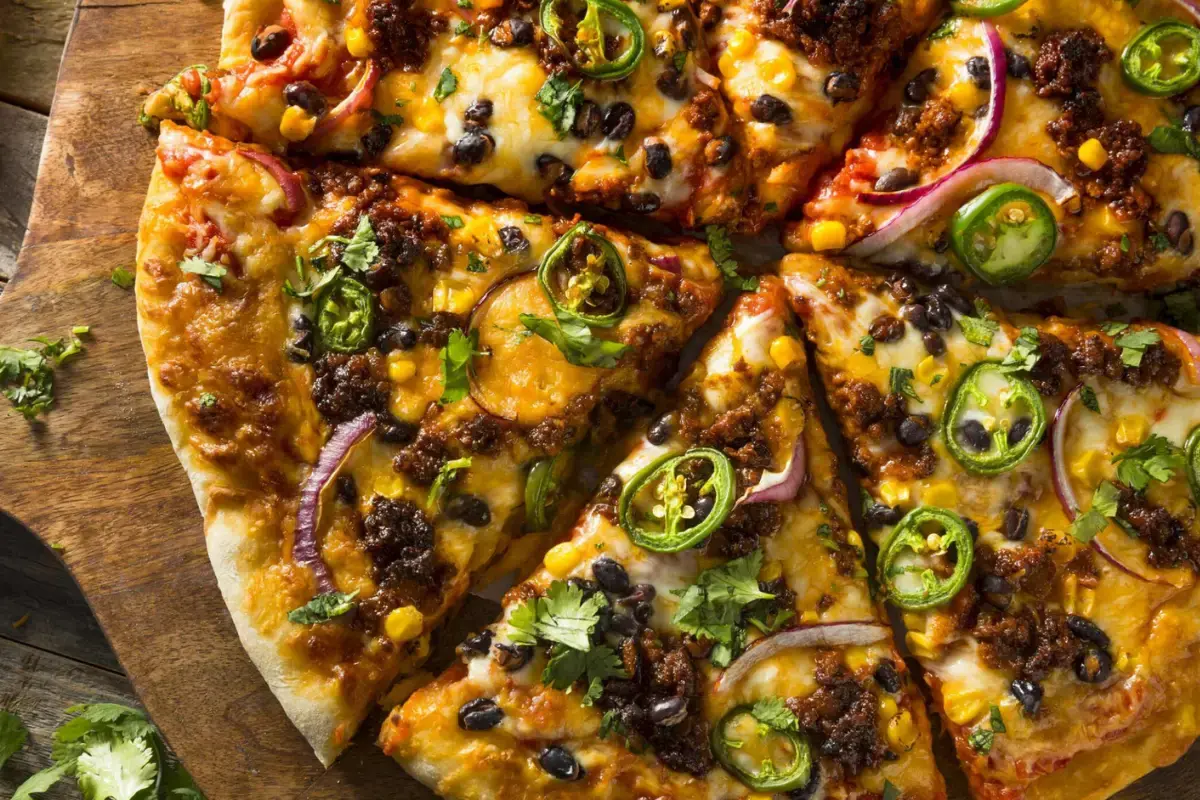In the culinary cosmos, where traditions blend and cultures converge, Mexican pizza stands out as a testament to culinary innovation and cultural amalgamation. This article embarks on a savory journey, exploring the layers, flavors, and history of Mexican pizza, a dish that has tantalized taste buds far beyond its origins. From its humble beginnings to becoming a fast-food favorite and eventually a homemade delight, we’ll uncover the secrets behind its ingredients, preparation, and the myriad ways to customize it to your palate. So, buckle up for a flavorful adventure that promises to enrich your dining table and maybe, just maybe, inspire your next culinary creation.
Part 1: Introduction to Mexican Pizza
Ah, Mexican pizza, a dish that dances on the taste buds and sings to the souls of food lovers everywhere. But what exactly is this culinary marvel that has captured the hearts and stomachs of so many? At its core, Mexican pizza is a vibrant fusion of Mexican flavors and the classic structure of a pizza, creating a dish that is both familiar and excitingly new.
Brief History and Origin
The journey of Mexican pizza began in the kitchens of those who dared to blend the bold flavors of Mexican cuisine with the universally beloved pizza. However, it was popularized by none other than Taco Bell, turning it into a fast-food sensation that combined crispy tortillas, savory fillings, and melty cheese. Despite its fast-food origins, the essence of Mexican pizza lies in its adaptability and the joy it brings to the dinner table.
For those eager to dive deeper into the world of culinary delights, exploring the Ultimate Guide to Making Cake Pops can offer additional inspiration for creative cooking and baking. Similarly, the Mastering Mini Cheesecakes Baking Guide provides a detailed look into crafting another beloved treat, showcasing the versatility and joy of homemade desserts. These resources can serve as a rich source of culinary knowledge and inspiration, enhancing your cooking and baking adventures.
Popularity and Cultural Significance
Mexican pizza’s popularity isn’t just a testament to its deliciousness but also to its ability to bridge cultures. It’s a dish that invites experimentation, making it a favorite among home cooks and professional chefs alike. Its cultural significance goes beyond mere taste; it represents a fusion of traditions, a celebration of culinary creativity, and the joy of sharing good food with loved ones.
So, as we dive deeper into the layers of Mexican pizza, let’s appreciate not just the flavors and techniques that make it special but also the stories and connections it fosters. Whether you’re a die-hard fan of Taco Bell’s version or a home cook looking to put your spin on this classic, there’s no denying the charm and appeal of Mexican pizza.
Ingredients and Preparation
Creating a Mexican pizza that rivals even the most beloved Taco Bell version starts with gathering the right ingredients and knowing how to prepare them. Let’s dive into the essentials and some clever twists you can apply to make this dish uniquely yours.
Ingredients of Mexican Pizza
The foundation of a mouthwatering Mexican pizza lies in its ingredients. At its core, you’ll need:
- Tortillas: flour or corn; each has its own texture and taste.
- Refried beans: a creamy layer that adds depth.
- Ground beef, or turkey, is the main protein, seasoned to perfection.
- Taco Seasoning: For that authentic Mexican flavor.
- Enchilada Sauce: Adds moisture and tang.
- Colby Jack Cheese: Melty goodness that binds all the flavors.
- Diced Tomatoes: A fresh burst in every bite.
For those looking to shake things up, consider black olives, green onions, or even a sprinkle of cilantro. The beauty of Mexican pizza is its versatility, which allows for endless customization.
Preparing the Base
Choosing between flour and corn tortillas is more than a matter of taste; it’s about achieving the perfect crisp. Flour tortillas tend to offer a softer, more pliable base, ideal for those who enjoy a chewier texture. Corn tortillas, on the other hand, can provide a delightful crunch, especially when toasted to golden perfection.
To get that ideal crisp, lightly brush your tortillas with oil and bake or fry until they’re just right. Keep an eye on them; the line between perfectly crispy and burnt is a fine one.
The Filling
While traditional Mexican pizza features ground beef, swapping it out for ground turkey can lighten the dish without sacrificing flavor. Season generously with taco seasoning to ensure every bite is as delicious as the last.
For a vegetarian twist, skip the meat altogether and double down on the beans, or introduce a mix of sautéed vegetables. Bell peppers, onions, and mushrooms can add texture and flavor depth, making the pizza satisfying for everyone at the table.
Assembling the Mexican Pizza
Layering is key to a balanced Mexican pizza. Start with a crispy tortilla base, followed by a smear of refried beans. This not only adds flavor but also helps the next layer of seasoned meat (or veggies) stick. Another tortilla caps off this layer, acting as a canvas for the enchilada sauce, cheese, and tomatoes.
Ensuring the right balance of ingredients is crucial; too much sauce and your pizza may become soggy; too little cheese and it may lack richness. Aim for harmony in each layer, and you’ll have a Mexican pizza that’s both delicious and structurally sound, ready to be devoured by eager diners.
Cooking Mexican Pizza
Baking vs. Frying
When it comes to cooking your Mexican pizza, you’ve got two paths: baking or frying. Each method has its fans and its reasons.
Baking is the hands-off hero. Pop your assembled pizza in the oven, and you’re free to prep a side or simply relax. It’s also the healthier option, cutting down on oil without skimping on flavor. The downside? It might not get as crispy as some crave.
Frying, on the flip side, guarantees that sought-after crunch. It’s quick and delivers on texture, giving you that authentic Taco Bell vibe. But it’s messier and packs more calories.
For that perfect crisp, regardless of method, pre-cook your tortillas until they’re just shy of golden. This little trick ensures a base that can stand up to the toppings.
Final Touches and Serving
Once cooked, it’s time to dress up your Mexican pizza. A sprinkle of fresh cilantro or diced green onions can add a pop of color and freshness. Sliced avocados or a dollop of sour cream can soften spicy bites, while a squeeze of lime brightens the whole dish.
Serving is straightforward. Slice it like a pizza and serve immediately. For a complete meal, pair it with a side of Mexican rice or a simple salad. The contrast of flavors and textures will make your meal even more enjoyable.
Remember, the beauty of Mexican pizza lies in its flexibility. Feel free to experiment with toppings and sides. The goal is a delicious meal that brings smiles all around.
Customizations and Variations
Customizing Your Mexican Pizza
The true charm of Mexican pizza lies in its adaptability. It’s a canvas waiting for your personal touch. Start with the base—while traditional recipes call for tortillas, experimenting with different grains can introduce new textures. Think quinoa or cauliflower crusts for a healthy twist.
Across regions, variations abound. Some might top their pizza with spicy chorizo or succulent shrimp, reflecting local flavors and preferences. In coastal areas, seafood versions are popular, showcasing fresh catches of the day.
Incorporating regional cheeses can also transform your pizza. Swap out Colby Jack for Oaxaca cheese for a more authentic Mexican taste, or use a vegan cheese to keep it dairy-free. The possibilities are endless, inviting you to explore and experiment.
Dietary Adjustments
Adapting Mexican pizza for dietary needs is simpler than you might think. For a gluten-free version, ensure your tortillas are made from corn or another gluten-free grain. Checking labels is key, as some corn tortillas can contain traces of wheat.
Vegans can rejoice with easy swaps. Use plant-based ground alternatives for the meat, and opt for vegan cheese and sour cream. Refried beans are already a great vegan protein source; just make sure they’re not prepared with lard.
For those avoiding nightshades, a green enchilada sauce made from tomatillos can replace traditional red sauce, offering a tangy twist without the tomatoes and peppers.
By keeping these customizations in mind, Mexican pizza can be a delightful dish for anyone, regardless of dietary restrictions or preferences. It’s all about making it your own, ensuring everyone can enjoy this versatile and delicious meal.
FAQs
Frequently Asked Questions
Can I make Mexican pizza ahead of time?
Absolutely! For those bustling days, you can assemble your Mexican pizza in advance. Just keep the components separate until you’re ready to bake or fry. This way, the tortillas stay crisp and the toppings are fresh. When dinner time rolls around, simply layer, cook, and serve. It’s a real time-saver.
Is Mexican pizza healthy?
Well, it depends on your choices. Traditionally, with cheese, meat, and fried tortillas, it’s more of a treat. However, by opting for lean meats, low-fat cheese, and baking instead of frying, you can certainly tilt it towards the healthier side. Including plenty of fresh veggies as toppings or sides also boosts its nutritional profile.
What’s the best way to reheat leftovers?
Reheating in an oven or toaster oven is ideal to keep that delightful crunch. Microwave reheating might make it a bit soggy. Spread out the slices on a baking sheet, heat at 350°F for a few minutes, and it’ll be almost as good as fresh.
Can I use store-bought taco seasoning?
Of course, store-bought taco seasoning is a convenient option. However, for those mindful of sodium or artificial additives, whipping up your own blend with spices like cumin, chili powder, and garlic powder is a fantastic alternative. Plus, you can adjust the heat to your liking.
Are there any vegetarian protein alternatives that work well?
Indeed, there are plenty of options. Black beans, lentils, or even quinoa make great substitutes for meat. For those looking for a similar texture, plant-based ground meat alternatives are widely available and work wonderfully in this dish.
Conclusion
In wrapping up, we’ve journeyed through the delightful world of Mexican pizza, exploring its versatile ingredients, preparation methods, and the joy of customizing it to suit any taste or dietary need. From the debate between baking and frying to the endless possibilities for toppings and variations, it’s clear that this dish is a canvas for culinary creativity.
So, why not roll up your sleeves and bring this beloved favorite into your kitchen? Experiment with the flavors and textures, make it your own, and most importantly, enjoy the process. Whether for a casual weeknight dinner or a festive gathering, homemade Mexican pizza promises a fun and flavorful experience. Give it a try, and discover the joy of creating a meal that’s uniquely yours.
For those interested in the rich history behind this beloved dish, the History of Taco Bell’s Mexican Pizza offers a fascinating glimpse into its evolution from a fast-food novelty to a homemade classic. Meanwhile, incorporating homemade ingredients can elevate your Mexican Pizza, and this Homemade Refried Beans Recipe is a great place to start. And for the authentic touch that truly makes a difference, this Guide to Authentic Mexican Ingredients can help you source the best products for your culinary creations.



